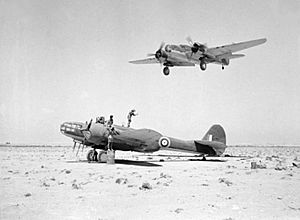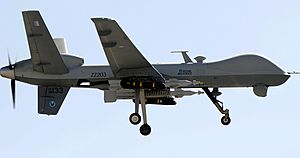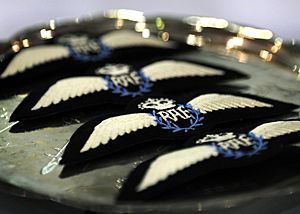No. 39 Squadron RAF facts for kids
Quick facts for kids No. 39 Squadron RAF |
|
|---|---|
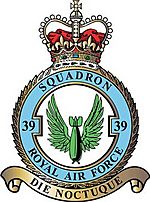
Squadron badge
|
|
| Active | 15 April 1916 – 1 April 1918 (RFC) 1 April 1918 – 16 November 1918 (RAF) 1 July 1919 – 8 September 1946 1 April 1948 – 28 February 1949 1 March 1949 – 30 June 1958 1 July 1958 – 1 June 1982 1 July 1992 – 28 July 2006 1 January 2007 – July 2022 |
| Country | |
| Branch | |
| Motto(s) | Die noctuque (Latin for 'By day and night') |
| Battle honours |
|
| Insignia | |
| Squadron badge heraldry | A winged bomb |
| Squadron codes | SF (Apr 1939 – Sep 1939) (Allocated but probably not carried) XZ (Sep 1939 – Dec 1940) AA–AZ (Canberras) |
| Squadron roundel |  |
Number 39 Squadron was a special unit of the Royal Air Force (RAF). It flew advanced aircraft for many years. The squadron was last active from January 2007 to July 2022. During this time, it operated the General Atomics MQ-9 Reaper drone from Creech Air Force Base in Nevada, USA.
Before that, from July 1992 to July 2006, it was known as No. 39 (1 Photographic Reconnaissance Unit) Squadron. It flew English Electric Canberra planes for taking photos from the air. These operations were based at RAF Marham in Norfolk, UK.
Contents
History of No. 39 Squadron
First World War Service
No. 39 Squadron was created on April 15, 1916. It started at Hounslow Heath Aerodrome in England. The squadron used Royal Aircraft Factory B.E.2 and B.E.12 planes. Their main job was to protect London from German airship attacks. These airships were called Zeppelins.
The squadron moved to RFC Suttons Farm. On September 2, 1916, they had their first big success. Lieutenant William Leefe Robinson shot down a German airship called Schütte-Lanz SL11. He received the Victoria Cross, a very brave award, for this action.
Later that month, on September 23, 1916, German airships attacked London again. Second Lieutenant Frederick Sowrey of No. 39 Squadron shot down Zeppelin L.32. Another pilot, Alfred Brandon, attacked Zeppelin L.33. This airship was already damaged and had to land. Its crew then destroyed it.
On October 1, 1916, Second Lieutenant W. L. Tempest of No. 39 Squadron spotted Zeppelin L.31. He was flying a B.E.2c plane. He shot it down over London, and sadly, the entire airship crew was lost.
The squadron kept defending London. They added three Royal Aircraft Factory S.E.5 planes to help fight German Gotha bombers during the day. They also used at least one Armstrong Whitworth F.K.8. In September 1917, the squadron got new Bristol F.2 Fighter planes. They had another success on May 19, 1918, when one of their Bristol Fighters shot down a Gotha bomber. In October 1918, they received Royal Aircraft Factory F.E.2b aircraft. These were sent to France for night bombing. However, the squadron was disbanded just five days after the war ended.
Between the World Wars
No. 39 Squadron was formed again on July 1, 1919. This happened when No. 37 Squadron at RAF Biggin Hill was given the new number. The squadron became smaller in December 1919 but did not completely close. In April 1921, it was decided to make the squadron fully active again.
By May 1921, the squadron had enough people. They received Avro 504 planes to train pilots. In February 1923, the squadron moved to RAF Spitalgate in Lincolnshire. They received 18 Airco DH.9A planes. The squadron trained for bombing missions during the day. They also performed amazing formation flying displays. These displays were part of the RAF Air Pageant at RAF Hendon in 1923, 1926, and 1927.
In January 1928, the squadron moved to RAF Bircham Newton in Norfolk. Here, they got ready to move to British India.
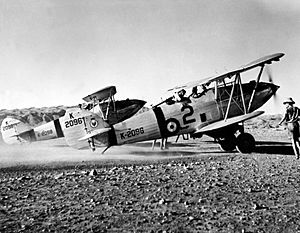
In December 1929, the squadron left the UK. They left their old planes for No. 101 Squadron. They arrived in Risalpur, North-West Frontier Province in India (now Pakistan), in January 1929. In March, they received twelve Westland Wapiti planes.
The squadron helped keep peace in the North West Frontier. They carried out bombing missions against groups who were causing trouble. They also supported the army. In December 1931, they received Hawker Hart planes. They continued their missions. They also helped after the 1935 Quetta earthquake. They flew supplies to the damaged city of Quetta and helped move injured people. They also supported military operations against local groups in 1935 and 1938.
Second World War Operations
In 1939, the squadron got newer Bristol Blenheim I bombers. As war seemed more likely, it was decided to send No. 39 Squadron to Singapore to make British defences stronger in the Far East. They set off with nine Blenheim planes on August 6. This journey was very difficult. Six planes were damaged, and three men died.
In April 1940, the squadron was ordered back to India. They arrived in Lahore on April 25. Then, they were sent to strengthen defences in the Middle East. They were ordered to Aden and arrived there in May and June 1940.
On June 10, Italy declared war on Great Britain and France. No. 39 Squadron quickly began fighting against Italian East Africa. Their first mission was on June 12. Blenheim planes attacked Dire Dawa airfield in Ethiopia. The squadron continued operations until November 24. Then, they were ordered to Egypt to support a planned attack in the Western Desert.
A small group of three Blenheim planes worked with No. 45 Squadron from December 10. They flew missions to bother Italian airfields. The rest of the squadron stayed at Helwan to recover and get newer Blenheim IV planes. In January, the squadron was told to give their Blenheims to 11 Squadron.
To replace their planes, No. 39 Squadron received Martin Maryland bombers. These planes were first built for the French Air Force. No. 39 Squadron was the first RAF squadron to use the Maryland. Because the Maryland could fly long distances, No. 39 Squadron used it mainly for scouting and taking pictures. The squadron was very active during the Battle of Crete. They claimed to have shot down at least two German transport planes during this battle.
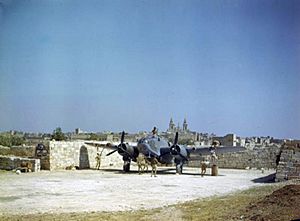
In August and September 1941, the squadron partly switched to the Bristol Beaufort torpedo bomber. These planes were used for attacking ships. They kept some Maryland planes until January 1942. At first, the Beauforts used bombs. But from January 1942, they started using torpedoes. On January 23, 1942, three Beauforts attacked an Italian convoy near Benghazi. They hit the troopship MS Victoria with two torpedoes. Another torpedo hit later that day, causing the Victoria to sink.
In late 1941, the squadron was split up. One part moved to Luqa, Malta in December 1941. Six months later, this group joined with others to form a new No. 39 Squadron. In 1943, the unit got Bristol Beaufighter planes. These were used for attacking targets on the ground. They moved back to Egypt and then to Italy. During the Greek Civil War, they sent planes with rockets to help. In December 1944, they got Martin Marauder planes. They flew bombing missions to support Tito's Partisans (local fighters). They received de Havilland Mosquito planes in 1946 before being disbanded later that year.
Cold War Era
The squadron was formed again on April 1, 1948. It became a fighter squadron using the Hawker Tempest at Nairobi. It disbanded on February 28, 1949. But it reformed the very next day at RAF Fayid in Egypt. This time, it flew de Havilland Mosquito NF Mk 36 night fighters. The squadron moved to nearby RAF Kabrit on February 21, 1951.
In 1951, there were growing tensions between British forces in the Suez Canal Zone and Egyptians. After anti-British riots in Cairo in January 1952, the squadron was ready to help if the situation got worse. The Egyptian army stepped in and stopped the riots, which calmed things down.
The squadron got new Gloster Meteor NF.13 night fighters in March 1953. But the British position in Egypt became difficult. In October 1954, an agreement was signed for Britain to leave Egypt by June 1956. As part of this, No. 39 Squadron moved to RAF Luqa in Malta on January 10, 1955.
The squadron moved to RAF Akrotiri on Cyprus in August 1956. This was because Britain and France were preparing to respond to Egypt taking control of the Suez Canal. On October 31, Britain and France launched Operation Musketeer. This involved air attacks and landings. No. 39 Squadron's job was to protect the important airfields on Cyprus.
The United Nations pushed for a ceasefire, and British and French forces left Egypt by December. But the squadron stayed in Cyprus. They flew patrols to stop planes suspected of dropping supplies to groups fighting against British rule. The main part of the squadron returned to Malta in March 1957. However, a small group stayed on Cyprus.
Problems in Lebanon caused the whole squadron to move to Cyprus in May 1958. But they soon returned to Malta and disbanded on June 30, 1958.
No. 39 Squadron reformed the next day at RAF Luqa. This happened by simply changing the number of No. 69 Squadron. They flew English Electric Canberra PR.3s for high-altitude scouting. They were part of NATO's air force. The squadron moved to RAF Wyton in September 1970 and disbanded on June 1, 1982.
No. 1 Photographic Reconnaissance Unit
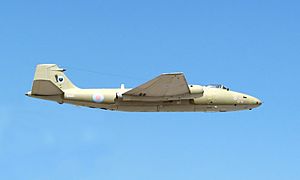
The squadron was reformed on July 1, 1992. This happened when No. 1 Photographic Reconnaissance Unit (1 PRU) at RAF Wyton was re-numbered. This unit flew Canberra PR.9 and T.4 aircraft. It became No. 39 (1 PRU) Squadron.
The unit moved to RAF Marham in December 1993. Here, they also received Canberra PR.7s. In December 1996, the squadron went to Uganda. Their mission was to search for Rwandan refugees in eastern Zaire. Between 1996 and 2001, No. 39 (1 PRU) Squadron went to Kenya and Zimbabwe six times. They carried out photo-mapping missions.
From October 2001 to January 2002, the squadron sent two Canberra PR.9s to Seeb International Airport in Oman. From there, they flew missions over Afghanistan as part of military operations. In 2003, the unit went to Azraq Air Base in Jordan. This was to support Operation Telic. On September 8, 2003, Canberra PR.9 XH168 was damaged after its landing gear tires burst at RAF Marham. The crew was not hurt. In November 2003, two Canberra PR.9s went to RAF Mount Pleasant, Falkland Islands, for survey work.
On September 2, 2004, Canberra T.4 WJ866 crashed at RAF Marham during a night landing practice. Both pilots died, and the navigator was injured. This was the last time an operational Canberra was lost by the RAF. No. 39 (1 PRU) Squadron flew the last RAF flight of a Canberra T.4 (WJ874) on September 1, 2005. This marked the end of 45 years of service for this type of plane.
In January 2006, No. 39 (1 PRU) Squadron went to Afghanistan for the last time. This was to support Operation Herrick. The two Canberra PR.9s returned to RAF Marham on June 23, 2006. This marked the end of the Canberra's active service. The squadron disbanded on July 28, 2006, at RAF Marham. The last three Canberras flew from Marham to Kemble Airfield on July 31, 2006.
RPAS (Remotely Piloted Air System) Era
In January 2004, a new unit called No. 1115 Flight was formed. It was based at Creech Air Force Base in Nevada, USA. This unit was created to fly the RAF's first Remotely-piloted Air System (RPAS). They operated the General Atomics MQ-1 Predator drone. The unit worked closely with the United States Air Force.
RAF crews started training on the General Atomics MQ-9A Reaper in late 2006. No. 39 Squadron was reformed on January 1, 2007, at Creech AFB. No. 1115 Flight became 'A' Flight and continued to operate the Predator. 'B' Flight got ready to receive the Reaper.
The squadron's first Reaper drone (ZZ200) was sent to Afghanistan in October 2007. It officially started service with the RAF on October 31. On November 9, 2007, the Ministry of Defence announced that the squadron's MQ-9 Reapers had begun missions in Afghanistan against the Taliban. On January 23, 2008, No. 39 Squadron received a new squadron Standard (a special flag).
On April 9, 2008, MQ-9A Reaper ZZ200 was destroyed. It made a forced landing in southern Afghanistan to stop it from being captured. By March 2009, the squadron had 12 teams of three people to pilot its Reaper aircraft. With intelligence specialists, IT experts, signallers, and weather experts, the squadron had about 90 people. The squadron had two aircraft but planned to have six by the end of 2009. By April 2011, five Reaper aircraft were in use, with five more ordered. By September 2016, the squadron had ten operational Reaper aircraft. They were flying missions in Syria as part of Operation Shader.
No. 39 Squadron was given the special award 'Afghanistan 2001–2014' on March 24, 2020. This was for their part in Operation Herrick.
The squadron disbanded in July 2022. A Reaper Ground Control System was sent from Creech AFB to RAF Waddington. It is now used by No. 13 Squadron. No. 39 Squadron flew 90,000 hours of drone operations while based at Creech AFB. The last commander of No. 39 Squadron became the Station Commander for RAF Marham in September 2022. The squadron's Standard was placed in the Rotunda at College Hall Officers’ Mess at Royal Air Force College Cranwell in February 2023.
Aircraft Operated by No. 39 Squadron
From 1916, unless stated otherwise
- Royal Aircraft Factory BE.2c, d, e — April 1916 – 1917
- Royal Aircraft Factory BE.12 — April 1916 – 1917
- Royal Aircraft Factory SE.5a — 1917
- Bristol F.2 Fighter — 1917 – November 1918
- Avro 504 — 1921
- Airco DH.9A — February 1923 – December 1928
- Westland Wapiti — 1928 – November 1931
- Hawker Hart — November 1931 – August 1939
- Bristol Blenheim I, IV — August 1939 – January 1941
- Martin Maryland — January 1941 – January 1942
- Bristol Beaufort — August 1941 – June 1943
- Bristol Beaufighter — June 1943 – December 1944
- Martin Marauder — December 1944 – September 1946
- de Havilland Mosquito FB.VI, T3 — January 1946 – September 1946
- Hawker Tempest VI — June 1948 – March 1949
- de Havilland Mosquito NF.36, T.3 — June 1949 – March 1953
- Gloster Meteor NF.13 — March 1953 – June 1958
- English Electric Canberra PR.3, PR.7, PR.9, T.4 — June 1958 – June 1982
- English Electric Canberra PR.9, PR.7 — July 1992 – July 2006
- General Atomics MQ-1 Predator — January 2007 – 20??
- General Atomics MQ-9 Reaper — October 2007 – July 2022
See also
- List of Royal Air Force aircraft squadrons


